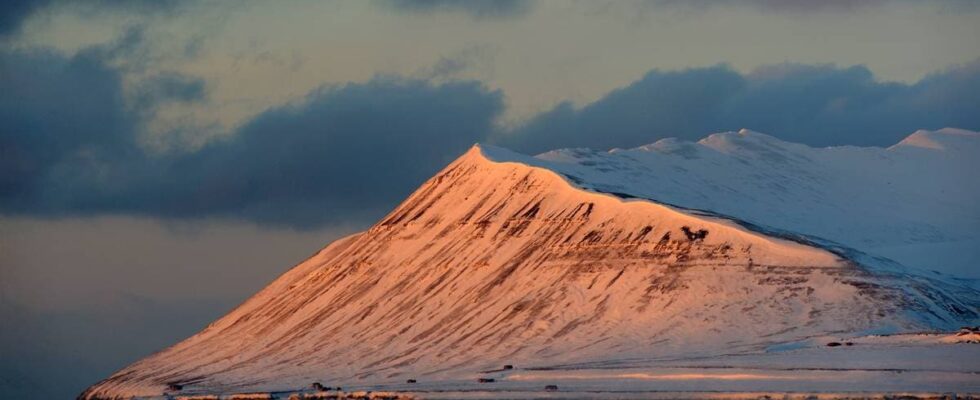In 1912, the author of Sherlock Holmes, Arthur Conan Doyle, published a novel about a mountain plateau in South America where dinosaurs still existed: “The Lost World”. I would argue that in a few decades we will have a real lost world: Svalbard. Svalbard is one of the few places on earth where much of the history of life over the past 700 million years can be studied in the mountainsides. The mountains consist of deposits from old lakes, marshes, rivers and seas. They are full of fossils. These remains of extinct animals and plants are the time witnesses to a world we can never return to, and can only understand through the fossils. Understanding life’s past can also enable us to understand species extinctions and climate change in a broader perspective. Fossils can tell us who we are and where we came from millions of years ago. Octopus shells (ammonites) on Knorringfjellet in Svalbard. Photo: Hans Arne Nakrem There are many examples of what the fossils from the mountain sides of Svalbard have given us an understanding of: Dinosaur biology: In 1960, the discovery of dinosaur footprints at the Fortress became a world sensation. This was the first indisputable evidence that dinosaurs had lived in cold areas. Our understanding of dinosaurs changed forever, from cod animals in warm climates to active animals that lived all over the world. Our brain’s early development: Some of the oldest known brains were reconstructed from 415-million-year-old jawless fish from the mountains around Woodfjorden. The first forests: In Plantekløfta near Munindalen, one of the world’s oldest forests has been found, with 380 million-year-old trees. An ecosystem in the sea from when the dinosaurs ruled on land: On Janusfjellet, 150-million-year-old fish lizards and swan lizards have been excavated. Fiskeegle is excavated on Janusfjellet in Svalbard. Photo: Jørn H. Hurum Recently, the greenhouse effect increased a lot: At Longyearbreen fossils are found from a 52-million-year-old deciduous forest, when it was so hot that the water at the North Pole was bathing temperature. Life’s robustness and possibilities: The fossils at Vindodden tell about how life recovered from the biggest mass extinction in the history of life, 252 million years ago. Due to limited vegetation, it is the permafrost that mainly stabilizes the steep mountain sides with fossils in Svalbard. These mountain sides are now threatened. With rising temperatures, a deeper part of the top layer of the permafrost melts during the summer thaw, leading to mudslides covering large areas. Two mountain pages the chronicler has worked on which are now gone. Both on Knorringfjellet in Svalbard. Photo: Hans Arne Nakrem / Museum of Natural History Imagine the mountains on Svalbard as layered ice cream cakes. As long as the cake is frozen, you can clearly see the layers of different berries. When the cake melts, the layers are mixed into a sauce that seeps down. It is no longer possible to see which layers which berries come from. This is also the case with the fossils. It becomes impossible to know exactly where they come from, although we may be lucky to find some in the mud. I myself am a time witness to this after fieldwork in Svalbard for 25 years. Especially during the last 20 years of excavations, we in the research group have documented the loss of sites to mudslides and seen how fossils disappear. Many world-renowned fossil sites on Svalbard will suffer the same fate within a few decades. In some cases, we are already too late, and historical collections in museums are all that is preserved from places now lost to science. Can we do something to prevent this from happening? I don’t think the warming will stop so fast that the mountainsides will be preserved. Documentation is the only thing we can do to save this life’s archive for the future. The chronicler in Svalbard. Photo: Pål Solum / news For over 150 years, natural history museums and universities have sent expeditions to Svalbard to collect fossils for research. Together, European institutions house large collections of Svalbard’s fossils. But there is currently no overview of where and what is found in museums and institutes around Europe. As many of the mountain sides will be lost within the next 50 years, and fossils will then only be found in museum collections, it is important to get such an overview. What is often missing is documentation of the mountain sides as they look now. When the landslide has passed, it is important that researchers can still use the museum material and see what it looked like when the area was accessible. It is urgent to document these mountain sides and the fossil wealth on Svalbard. Many of the chapters in life’s long history will be lost in mudslides. Aerial photo from Svalbard taken by the writer. Photo: Jørn H. Hurum / Published 20.10.2024, at 09.40
ttn-69
Svalbard’s lost world – Expression

